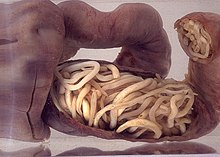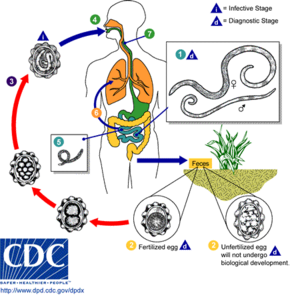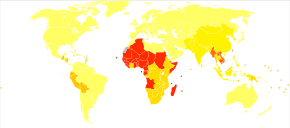Ascariasis
| Ascariasis | |
|---|---|
pyrantel pamoate[2] | |
| Frequency | 762 million (2015)[3] |
| Deaths | 2,700 (2015)[4] |
Ascariasis is a disease caused by the parasitic
Infection occurs by ingestion of food or drink contaminated with Ascaris eggs from feces.
Prevention is by improved
About 0.8 to 1.2 billion people globally have ascariasis, with the most heavily affected populations being in
Signs and symptoms
In populations where worm infections are widespread, it is common to find that most people are infected by a small number of worms, while a small number of people are heavily infected. This is characteristic of many types of worm infections.[1][13] Those people who are infected with only a small number of worms usually have no symptoms.[14]
Migrating larvae
As larval stages travel through the body, they may cause visceral damage,
Intestinal blockage

The worms can occasionally cause intestinal blockage when large numbers get tangled into a bolus or they may migrate from the small intestine, which may require surgery.[17] More than 796 A. lumbricoides worms weighing up to 550 g (19 oz) were recovered at autopsy from a two-year-old South African girl. The worms had caused torsion and gangrene of the ileum, which was interpreted as the cause of death.[18]
The worms lack teeth. However, they can rarely cause bowel perforations by inducing volvulus and closed-loop obstruction.[citation needed]
Bowel obstruction
]Allergies
Ascariasis may result in
Malnutrition
The worms in the intestine may cause malabsorption and anorexia, which contribute to malnutrition.[22] The malabsorption may be due to a loss of brush border enzymes, erosion and flattening of the villi, and inflammation of the lamina propria.[23]
Others
Ascaris have an aversion to some general anesthetics and may exit the body, sometimes through the mouth, when an infected individual is put under
Cause
-
The larva of Ascaris lumbricoides developing in the egg
-
Ascaris lumbricoides adult worms (with measuring tape for scale)
-
Ascaris lumbricoides adult worms
-
Ascaris egg, incubation process: The Ascaris egg incubation process consists of placing the egg in a controlled environment, at 26 °C (79 °F) during 28 days, in acidic conditions. This process allows for the evaluation of an egg to determine if it is viable or not.

Transmission
The source of infection is from objects which have been contaminated with fecal matter containing eggs.[2] Ingestion of infective eggs from soil contaminated with human feces or contaminated vegetables and water is the primary route of infection. Infectious eggs may occur on other objects such as hands, money and furniture.[2] Transmission from human to human by direct contact is impossible.[25]
Transmission comes through municipal recycling of wastewater into crop fields. This is quite common in emerging industrial economies and poses serious risks for local crop sales and exports of contaminated vegetables. A 1986 outbreak of ascariasis in Italy was traced to irresponsible wastewater recycling used to grow
The number of
- In a study published in 1992, municipal wastewater in Riyadh, Saudi Arabia, detected over 100 eggs per litre of wastewater[27] and in Czechoslovakia was as high as 240–1050 eggs per litre.[28]
- In one field study in Marrakech, Morocco, where raw sewage is used to fertilize crop fields, Ascaris eggs were detected at the rate of 0.18 eggs/kg in potatoes, 0.27 eggs/kg in turnip, 4.63 eggs/kg in mint, 0.7 eggs/kg in carrots, and 1.64 eggs/kg in radish.helminths, particularly Ascaris, probably as a result of exposure to the raw sewage.[citation needed]
Lifecycle
The first appearance of eggs in stools is 60–70 days. In larval ascariasis, symptoms occur 4–16 days after infection. The final symptoms are gastrointestinal discomfort, colic and vomiting, fever, and observation of live worms in stools. Some patients may have pulmonary symptoms or neurological disorders during migration of the larvae. There are generally few or no symptoms. A bolus of worms may obstruct the intestine; migrating larvae may cause pneumonitis and eosinophilia. Adult worms have a lifespan of 1–2 years which means that individuals may be infected all their lives as worms die and new worms are acquired.[13]
Eggs can survive potentially for 15 years and a single worm may produce 200,000 eggs a day.[2] They maintain their position by swimming against the intestinal flow.[30]
Mechanism
Ascaris takes most of its nutrients from the partially digested host food in the intestine. There is some evidence that it can secrete enzyme inhibitors, presumably to protect itself from digestion by the hosts' enzymes. Children are often more severely affected.[1]
Diagnosis
Most
Prevention
Prevention is by improved access to sanitation which includes the use of properly functioning and clean toilets by all community members as one important aspect.[1] Handwashing with soap may be protective; however, there is no evidence it affects the severity of the disease.[8] Eliminating the use of untreated human faeces as fertilizer is also important.[citation needed]
In areas where more than 20% of the population is affected treating everyone is recommended.
Treatment
Medications
Medications that are used to kill roundworms are called
Piperazine is a flaccid paralyzing agent that blocks the response of Ascaris muscle to acetylcholine, which immobilizes the worm. It prevents migration when treatment is accomplished with weak drugs such as thiabendazole. If used by itself, it causes the worm to be passed out in the feces and may be used when worms have caused blockage of the intestine or the biliary duct.[citation needed]
Other medications
- Hexylresorcinol effective in single dose.[35] During the 1940s a crystoid form of this compound was the treatment of choice;[36] patients were instructed not to chew the crystoids in order to prevent burns to the mucous membranes. A saline cathartic would be administered several hours later.[citation needed]
- Santonin, more toxic than hexylresorcinol[35] and often only partly effective.[37]
- Oil of chenopodium, more toxic than hexylresorcinol[35]
Surgery
In some cases with severe infestation the worms may cause bowel obstruction, requiring emergency surgery.[38] The bowel obstruction may be due to the number of worms in the bowel or twisting of the bowel.[38] During the surgery the worms may be manually removed.[38]
Prognosis
It is rare for infections to be life-threatening.[1]
Epidemiology


Regions
Ascariasis is common in tropical regions as well as subtropical and regions that lack proper sanitation. It is rare to find traces of the infection in developed or urban regions.[39]
Infection estimates
Roughly 0.8–1.3 billion individuals are infected with this intestinal worm, primarily in Africa and Asia.[1][2][11] About 120 to 220 million of these cases are symptomatic.[1]
Deaths
As of 2010, ascariasis caused about 2,700 directly attributable deaths, down from 3,400 in 1990.[12] The indirectly attributable deaths due to the malnutrition link may be much higher.[citation needed]
Research
There are two animal models, the mouse and pig, used in studying Ascaris infection.[40][41]
Other animals
Ascariasis is more common in young animals than mature ones, with signs including unthriftiness, potbelly, rough hair coat, and slow growth.[42]
In pigs, the infection is caused by Ascaris suum. It is characterized by poor weight gain, leading to financial losses for the farmer.[1]
In horses and other equines, the equine roundworm is Parascaris equorum.[citation needed]
Society and culture
Kings of England Richard III[43] and Henry VIII[44] both had ascariasis.
References
- ^ PMID 20934531.
- ^ PMID 20701574.
- PMID 27733282.
- PMID 27733281.
- ^ "Soil-transmitted helminth infections Fact sheet N°366". World Health Organization. June 2013. Archived from the original on 2014-02-21.
- ^ a b "Neglected Tropical Diseases". cdc.gov. June 6, 2011. Archived from the original on 4 December 2014. Retrieved 28 November 2014.
- PMID 22291577.
- ^ PMID 18789465.
- PMID 22590656.
- ^ PMID 20627144.
- ^ PMID 22325616.
- ^ S2CID 1541253.
- ^ a b Anderson RS, May RM (1991). Infectious diseases of humans. Dynamics and control. Oxford: Oxford Scientific Publications.
- ^ "Parasites - Ascariasis". C.D.C, U.S. Department of Health & Human Services. 20 October 2020. Retrieved 27 June 2021.
- ^ Torok E. Oxford Handbook Infect Dis and Microbiol, 2009
- ^ Fincham, J., Dhansay, A. (2006). Worms in SA's children – MRC Policy Brief Archived 2015-04-02 at the Wayback Machine. Nutritional Intervention Research Unit of the South African Medical Research Council, South Africa
- S2CID 15081841.
- PMID 3953945.
- ^ "Acute Cholangitis". The Lecturio Medical Concept Library. Retrieved 27 June 2021.
- ISBN 978-0-12-415895-5, archivedfrom the original on 2013-05-30
- PMID 18486690.
- PMID 18289159.
- ^ Stephenson LS (1987). The Impact of Helminth Infections on Human Nutrition. London: Taylor & Francis.
- PMID 10629158.
- ^ "AscarisInfection Fact Sheet". 2019-04-24. Archived from the original on 2010-05-31.
- ISBN 978-1-85166-035-3.
- PMID 1300348.
- PMID 1644362.
- PMID 10983530.
- ^ Crompton DW, Pawlowski ZS (1985). "Life history and development of Ascaris lumbricoides and the persistence of human ascariasis.". In Crompton DW, Nesheim MC, Pawlowski ZS (eds.). Ascariasis and its public health significance. London: Taylor & Francis.
- ISBN 0-85198-689-7.
- PMID 21731306.
- ISBN 978-9241547109. Archived(PDF) from the original on 2013-02-28.
- PMID 32289194.
- ^ a b c Holt, Jr Emmett L, McIntosh Rustin: Holt's Diseases of Infancy and Childhood: A Textbook for the Use of Students and Practitioners. Appleton and Co, New York,11th edition
- ^ "Clinical Aspects and Treatment of the More Common Intestinal Parasites of Man (TB-33)". Veterans Administration Technical Bulletin 1946 & 1947. 10: 1–14. 1948.
- ISBN 978-3-527-32669-3. Archivedfrom the original on 2017-09-08.
- ^ PMID 19562557.
- ^ "Parasites - Ascariasis". CDC, U.S. Department of Health & Human Services. 19 July 2019. Retrieved 27 June 2021.
- PMID 5090955.
- PMID 10348103.
- ^ "Parasites:Ascarids". eXtension. September 27, 2011. Archived from the original on 9 November 2014. Retrieved 9 November 2014.
- S2CID 42898331.
- ^ "Infected and Hunched: King Richard III Was Crawling with Roundworms". Live Science. 3 September 2013. Archived from the original on 2017-01-09. Retrieved 2017-01-07.
External links
- Image (warning, very graphic):Image 1
- CDC DPDx Parasitology Diagnostic Web Site




